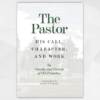Complementarianism: A Moment of Reckoning (Part 4)
Part 1: Today’s Tension: Broad Versus Narrow Complementarianism
Part 2: Different Intuitions and Pastoral Burdens
Part 3: How Do We Move Forward? A Better Understanding of Authority and Equality
Part 4: How Do We Move Forward? A Better Understanding of Abuse and Gender
Part 5: How Do We Move Forward? A Re-Commitment to the Sufficiency of Scripture
* * * * *
Part 4: How Do We Move Forward? A Better Understanding of Abuse and Gender
Insofar as the culture outside the church seeks to erase gender and redefine sexuality, I believe the more generationally urgent need is to grow in our understanding of authority and equality. They pertain to the challenges we feel from the outside.
Insofar as sinners in every generation tempt men and women alike to use whatever advantages they have to dominate others, we need a more biblical understanding of oppression and abuse. This is the more universally chronic challenge, and pertains to the challenges that arise inside the church and within our own hearts.
I believe Al Mohler is correct: male superiority and failing to correct abuse are two blind spots complementarians need to do a better job of addressing. (That said, it’s not clear to me egalitarian churches have a better understanding of abuse.) We need to spend more time studying the Scriptures and examining all the ways it addresses the abuse of authority.
For instance, consider how frequently and graphically the Psalms describes oppressive or violent men:
- Psalm 17:10–11: “They are uncaring; their mouths speak arrogantly. They advance against me; now they surround me. They are determined to throw me to the ground.”
- Psalm 55:21: “His speech was smooth as butter, yet war was in his heart; his words were softer than oil, yet they were drawn swords.”
- Psalm 140:3: “They make their tongues as sharp as a snake’s bite; viper’s venom is under their lips.”
Have we studied such passages? Have we searched out what the Prophets say about oppression? Have we considered how we might mimic Israel’s faithless kings? Have we studied how spiritually abusive the Pharisees were? Have we looked for their self-righteous patterns in ourselves?
Think of the wife of an emotionally abusive husband who presents her concerns to a pastor. She doesn’t do a very good job of explaining her situation, in part because she’s lost track of normalcy and in part because she feels love and loyalty to her husband. She doesn’t want to shame him. The pastor considers the husband, who presents himself in church as upstanding and godly. He quietly wonders if she has an unsubmissive attitude. So he concedes that, yes, perhaps her husband can be too severe. He needs sanctification, too. Yet he also asks her to consider her own sin and her role in the troubled marriage. His doctrine of depravity tells him there’s always fault on both sides. Since he’s a gospel-centered pastor, he talks about the need for forgiveness and reconciliation. And she, dutifully, forgives and adopts a posture of reconciliation.
Yet what has this pastor missed? He hasn’t learned the lesson of Psalm 55:21, that a man’s speech can be “smooth as butter” and “softer than oil,” even while there is “war in his heart” and his words at home are “drawn swords.” The wife knows it, of course, all too well.
The pastor’s quick recourse to “fault on both sides” fails to recognize the asymmetry created by the husband’s authority—that any given sin (say, a harsh word) by someone in authority is worse and more damaging than that exact same sin committed by a person under authority. His doctrine of depravity, ironically, is shallow, because it fails to dig deep into the travesty which is the abuse of authority and how such abuse lies profoundly about God. He has an under-biblical concept of oppression. And so his conversations about forgiveness and reconciliation are short-circuited. He doesn’t understand the cancer he’s treating, and so he fails to dig deep enough with his scalpel.
The Bible is rich with resources for understanding abuse and oppression, to say nothing of what we might learn from common grace sources. We who are complementarians should be among the first to mine the Scriptures for these purposes, so that we might better disciple the men and women in our churches.
WE NEED TO KEEP WORKING ON OUR BIBLICAL UNDERSTANDINGS OF MANHOOD AND WOMANHOOD
If God designed God-imagers in a male variety and in a female variety, then it would seem those design difference bear some significance in every domain. Form affects function. Further, it would seem that Christian discipleship should therefore entail understanding our maleness or femaleness. No, we should not exaggerate the differences, but can we give any substance to them beyond anatomy and chromosomes?
These are simple questions: “What is a man?” “What is a woman?” Yet the answers don’t come easily.
John Piper has famously defined masculinity as “a sense of benevolent responsibility to lead, provide for, and protect women in ways appropriate to a man’s differing relationships.” Femininity he defined as “a freeing disposition to affirm, receive, and nurture strength and leadership from worthy men in ways appropriate to a woman’s differing relationships.”
You don’t need to look far to find criticisms of his definitions, which is a fair thing to offer. Yet have the critics taken any time to offer better definitions?
My former church, Capitol Hill Baptist Church, teaches an adult Sunday School class on manhood and womanhood. The teachers liked elements of Piper’s definitions, but felt like they focused too much on the single element of authority (see also Bobby Jamieson’s concerns.) Therefore, the teachers offered these adaptations: “The essence of biblical masculinity is a sense of benevolent responsibility to tend God’s creation, provide for and protect others, and express loving, sacrificial leadership in particular contexts prescribed by God’s Word.”
Meanwhile: “Biblical femininity is displayed in a gracious disposition to cultivate life; to help others flourish; and to affirm, receive, and nurture strength and leadership from worthy men in particular contexts prescribed by God’s Word.”
These definitions were influenced by the writing of Alastair Roberts, who offers his attempt at distinguishing men and women here. The definition of womanhood sounds similar to what Abigail Dodds offers here. Our 9Marks Journal on complementarianism, in addition to Roberts, offers Kevin DeYoung’s attempt here.
None of these attempts should be regarded as final. Rather, we should encounter them as the collaborative work of friends, each attempt trying to push the ball forward a little. How many centuries did it take the church to define the Trinity or justification? Defining manhood and womanhood well will take some time, too, and it will inevitably be a collaborative, international effort, drawing insights from a multitude of national and cultural contexts.
What’s foolish and counterproductive, however, is to give up the attempt, or to quickly lambast every attempt as succumbing to cultural stereotypes. When it comes to manhood and womanhood, we all know instinctively (and biblically) there’s something there. It’s scary in our present cultural environment to say what it might be. But God’s people should not be afraid of the attempt.
Mary Kassian writes, “God’s design for gender is not only right, but it is also beautiful and good. Knowing Christ gives us the freedom to step into the fullness and joy of who God created us to be. He created us male and female. We cannot know ourselves, experience wholeness of personhood, or truly bring him glory, outside of this God-ordained context.” If that’s true, why aren’t we all working harder to gain a better understanding of manhood and womanhood? Are we concerned about wrongly binding consciences with culture instead of Bible? That’s a good concern. Or are we afraid of getting our hand slapped or being called backward? That’s not a good concern.
* * * * *
Read part five here.








